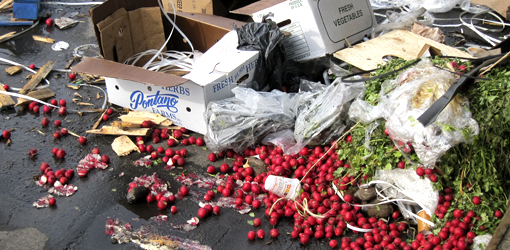Food Fights: A big messy problem
Posted on March 1, 2011 | posted by:Transdisciplinary: Is it a type of problem, the composition of a team, the strategy for resolution, or a discipline that transcends definition and by doing so creates a hybrid practice? To delve into the question, consider the primary focus of the Transdisciplinary Design Studio course. For the Spring Semester, the class has been tasked with re-imagining food systems in the South Bronx neighborhood of Hunts Point. The imbroglio is this: Hunts Point is the site of the worlds largest food distribution markets (Produce, Meat, and Fish). Ironically, the surrounding community that shares this peninsula with the market is the poorest congressional district in the United States. The community is a conduit for 60,000 trucks a week transporting nearly 40% of New York City’s food. Asthma rates are almost as high as obesity rates due to the lack of healthy food, low physical activity among residents, and surrounding industry that has negatively impacted the environmental conditions in Hunts Point. The area has been regarded as a poster child for urban blight. However, some organizations have taken charge of the community to create bottom-up change, including Sustainable South Bronx, Rocking the Boat, and The Point—to name a few. The TransDesign studio is aligning itself with various stake-holders to speculate on changes that may eventually contribute to the community.
The problem at hand has no starting point and no recognizable end. Food systems aren’t a topic to be solved but rather studied and understood from many different viewpoints. To do so, the twenty TransDesign students are engaged in an experimental methodological process that involves focused teamwork and widespread collaboration. Five teams, ranging in size from 2-6 members, are delving into meta-topics such as Infrastructures of Power, Daily Life / Psycho-geographies, Networks of Health, Food Systems, and Objective Environments. Several cross-coordinating committees communicate on topics including publication and fieldwork. The goal is to create synergy between these disparate lenses, while maintaining a strict research schedule.
Complexity is central to the TransDesign process. It is at the intersection of bodies of knowledge from various disciplines that innovation has the greatest chance of occurring. Hence, over the course of the semester, each meta-topic group will focus on different aspects of the food system as it relates to Hunts Point—investigating the consumption, distribution, and production phases of the system. After these stages of research are complete, an intensive speculation stage will commence. The effect is analogous to developing a small city of knowledge over 2/3 of the semester, with teams feeding information into the infrastructure. After our multi-faceted mini-metropolis is populated with knowledge, we will traverse the newly founded understanding of food systems in search of interventions and potential ruptures. The methodologies, design-led research strategies, visualizations of data, and knowledge generated in the process will define a Transdisciplinary Design approach to a “wicked problem” with no apparent start or end.
